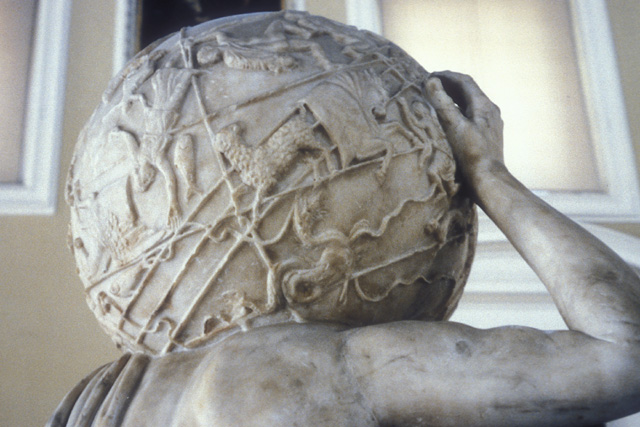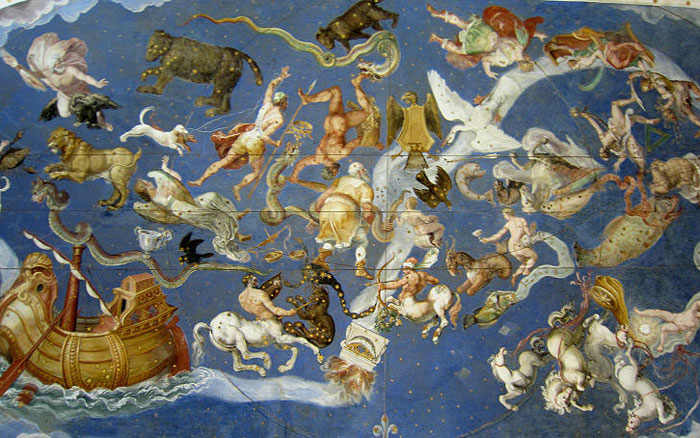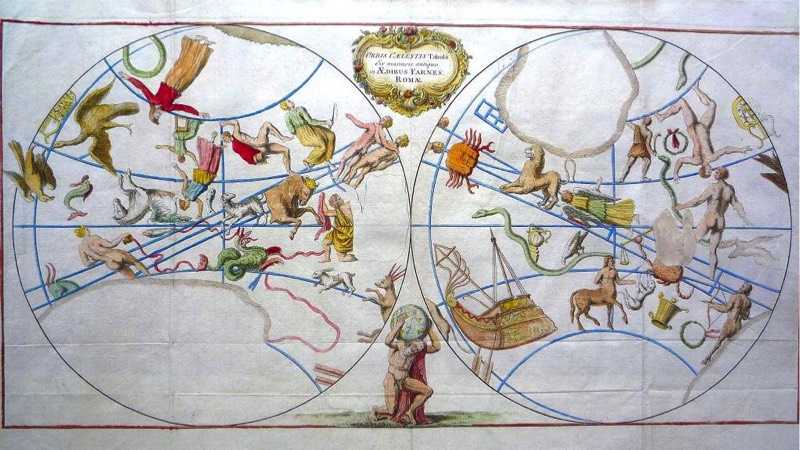By Alice Devine Wilson –
Wander into the enormous Roman sculpture galleries of the National Archaeological Museum in Naples, Italy and a strapping man carrying the weight of the world on his muscled shoulders may arrest your attention. In his crouched position on bended knee, his arms raised overhead to hold a celestial sphere, the bearded man exudes strength. Carved of marble, the sculpture of man and sphere is considered the “oldest depiction of the sky as the ancients saw it,” thus revealing ancient Greek and Roman astronomical knowledge. While questions remain because the statue is a copy of an earlier sculpture and because of its images, nevertheless, the art tells a story of its time. Further, the sculpture suggests a human connectedness to the heavens, in terms of knowledge, dependence, and perhaps, man’s own place in the immense universe.
Named the Farnese Atlas after its collectors ‘ the wealthy Italian Farnese family whose status included cardinals and popes with boundless appetites for antiquity ‘ and its subject, the sculpture is believed to be a 2nd century CE Roman copy of a Greek sculpture. At just over 7 feet tall, the sculpture’s scale expresses the immense size and strength of the Titan, Atlas, who is depicted carrying his burden. The sphere itself measures over 2 feet in diameter. The celestial sphere shows forty-one of the classical Greek constellations, etched in relief above a series of circles representing the Arctic Circle, Antarctica, the celestial equator, the tropics, the colures, and the ecliptic. The circles allow the constellations to be placed in relative position to one another. There, images – rather than individual stars – such as Aries the ram and Cygnes the swan dance around the celestial sky. In the same way that the sculpture’s scale mimics Atlas’s strength, so does scale represent the extensive observations of the skies.
Celestial Sphere
The celestial sphere, with its depictions of constellations atop circular lines that define the equator and Arctic Circle, represents a learned body of mathematics, physics, and astronomy. Several scholars have suggested that Hipparchus’s catalog of the stars served as the basis for the sculpture’s presentation of constellations. Hipparchus, developer of spherical trigonometry, coordinate system for each star’s location, and a ranking to classify a star’s brightness, is considered the founder of modern Astronomy. Unfortunately, only one of Hipparchus’ works, The Commentary, survives. However, Hipparchus is recorded as creating celestial spheres to represent the heavens. Importantly, the astronomer discovered “precession”, the wobbling as the earth rotates on its axis and the constellations shift over time. Therefore, the sky as it appeared to people on earth can be dated according to relative constellation location.
Rear View of the Celestial Sphere
In 2005, at an American Astronomical Society meeting, Dr. Bradley Schaefer, a professor of physics at Louisiana State University, presented an analysis concluding that Hipparchus’ long lost star catalog may have been the inspiration for the constellations on the Farnese Atlas, an expanded theory of an earlier proposal put forth by German scholar Georg Thiele in 1898. The thrust of Schaefer’s argument is that the timing of Hipparchus’s work, and the location of the constellations that appeared in the ancient Greek sky are consistent with this sculpture. The sculpture is dated 150 CE and Hipparchus’ seminal star catalog dates from 129 BCE Schaefer claims, “A chi-square analysis then shows the date of the constellations to be 125 BCE with a one-sigma uncertainly of 55 years”. Schaefer argues the sky’s appearance rules out other astronomers such as Ptolemy at 128 CE, Aratus at 275 BCE, Eudoxus at 366 BCE, and the original Assyrian observer at 1130 BCE.
Other historians refute Schaefer’s theory, saying that the sculpture is a piece of art, and as such, is not intended to be a precise scientific representation. In her abstract, Kristen Lippincott notes, “the role of the artist is neither as an inventor nor as a scientific draughtsman, but as a torch-bearer for the continuity of a specific set of widely accepted pictorial formulae.” As such, constellation location on the Farnese Atlas sphere would not announce a specific date. And thus, it is the sculpture’s story – rather than pure fact – that emerges as significant.
Fresco from the Palazzo Farnese Caprarola of Renaissance Cosmography, circa 1574
In yet another wrinkle, the copied sculpture leads one to question whether the statue is a precise replica or some derivation of the original. Perhaps the latter sculptor may have imposed his own artistic license. If so, the copy could have contained updated information relative to the heavens. Whether the Romans knew more than depicted on the sphere, or would have observed different positions of the constellations in the time period between creation of the original sculpture and the replica, remains unknown. However, even if the imitation deviated from the original, the sphere still reflects what the ancients knew at a particular point in time, whether from an individual scientist or a body (no pun intended) of acquired knowledge.
A color-coded depiction of the constellations recorded on the Farnese Atlas
The artist’s choice of line and realistic portrayal echoes his knowledge of the heavens. For example, the curving lines of the man’s limbs and muscles suggest fluidity and movement, like the solar system’s rotations. And the anatomical accuracy of the human body suggests an artist concerned with realistic representation. It seems logical that the sculptor who cared about carving the human physique in an accurate manner would give the same attention to his depiction of the skies. As such, Atlas holds not only the physical burden of the celestial sphere but also a body of knowledge that has been observed, calculated, and cataloged. Finally, the tremendous burden of the sphere implies that the universe beyond earth contains even more mystery, yet unplumbed.
The Myth of Atlas
The artist’s choice to portray a kneeling Atlas as he struggles to hold the sphere suggests an intertwining of human and heaven. Mythology can be seen as a way of making sense of the natural world through storytelling. The Titans, including Atlas, created by the universe and parents to the Greek gods of Olympus, were of enormous size and strength. As retribution for Zeus’s victory against the Titans, Zeus condemns Atlas, according to Edith Hamilton’s Greek Mythology:
To bear on his back forever
The cruel strength of the crushing world
And the vault of the sky.
Upon his shoulders the great pillar
That holds apart the earth and the heaven,
A load not easy to be borne.
Ultimately, Perseus turned Atlas to stone in what some say was an act of mercy as Atlas bore a heavy burden.
Making sense of the natural world forces an examination of relationship between man and nature. In this portrayal, Atlas is bowed by the heavens and the body of knowledge it contains, a literal example of the heavens exerting influence on man. At the same time, the heavens seem somewhat dependent upon Atlas. As the strong man holds the world on his shoulders with his head bowed to the side, he does not appear completely balanced, nor capable of holding the heavens forever. If Atlas crumbles under the weight, he may be injured or killed. Similarly, were the sphere to topple, universal chaos would ensue. As such, the artist has linked heavens and human together, each in relation to the other.
Additional elements in the piece’the stone and form’further connect heaven and earth. The sculpture is carved from marble, an actual extract of earth. And, while Atlas’s naked form is consistent with Hellenistic sculpture, tradition may be only one facet of his nakedness. In addition, the lack of clothing puts man and heaven in direct contact. These two bodies, man and sphere, representing earth and heaven, although discrete, are in direct contact with each other.
The implications of Atlas abandoning his task as a Titan are socio-politically allegorized in the 20th c. metaphor of moral responsibility in Ayn Rand’s Atlas Shrugged (1957) somewhat along the lines of Aldous Huxley’s Brave New World (1932) and George Orwell’s dystopian Nineteen Eighty-Four (1949), all of which examine rational self-interest and individual duty vis-a-vis the struggles between socialism and capitalism far beyond any anticipated different philosophical poles of Aristotle, Aquinas, Rousseau, Hobbes and Adam Smith. Atlas thus symbolizes the Titanic task of maintaining order in a roiling universe.
A Case of Mistaken Identity?
Hamilton’s Mythology also describes an incident where Hercules, who holds a cloak, tricks Atlas. Atlas had Hercules hold the sphere while he prepares to assist Hercules. Hercules agreed, temporarily, but after realizing Atlas might not return, Hercules asks Atlas to take back the sphere while Hercules adjusts his cloak. (Other stories mention “a pad on shoulders” or “a cushion”, but in all of these fabric is used to cushion the space between Hercules and the sphere.) When Atlas does so, Hercules departs, leaving Atlas holding the sphere for eternity. So, could the folds of material falling from Farnese Atlas indicate Hercules as the figure rather than Atlas? A drape or robe hangs from the left shoulder, and his full head of curly hair and beard shows vitality and maturity. These features are typical of Hercules.
One might argue that, because the constellation of Hercules, shown with the Nemean lion, is depicted on the globe, it would be redundant to represent Hercules as the holder of the sphere. Also, depictions of Hercules usually show him with a lion skin and club, representing one of his most well known victories. However, Hercules is a multifaceted character. Just look at his twelve mythological feats to realize his versatility. Thus, it seems possible that Hercules could indeed be represented below the sphere, engaged in yet another of his mythological feats or adventures.
How might the sculpture’s message change should the subject be Hercules rather than Atlas? Atlas and Hercules share similar depiction and attributes. Both men were renowned for their physical strength. Both bore the sphere on their shoulders, if for unequal amounts of time. In other sculptures of Atlas, he is portrayed with the sphere held high, or standing, as opposed to this sculpture that depicts a kneeling man, his head bowed to the side under its overhead weight.
In a comparison, “Atlas had worked out the science of astrology to a degree surpassing others and had ingeniously discovered the spherical arrangement of the stars, and for that reason was generally believed to be bearing the entire firmament upon his shoulders. Similarly in the case of Herakles (Heracles in Greek), when he had brought to the Greeks the doctrine of the sphere, he gained great fame, as if he had taken over the burden of the firmament which Atlas had borne, since men intimated in this enigmatic way what had actually taken place.” Thus, when referencing the heavens and topics associated with astronomy, historians and artists invoke both Atlas and Hercules.
Although strong, Hercules is not as mighty as Atlas. Atlas was a Titan in myth while Hercules was the mortal son of Zeus. Hercules is of the earth, which would make him an appropriate representative of all humans, especially in their relationship to the heavens. So, perhaps the artist has used the similarity of Atlas and Hercules to play upon the story, as we contemplate what it means for man to relate to the gods and heavens above. Indeed, Hercules may be just the man to represent the challenges of man.
Man’s Place in the Universe
Whether Atlas or Hercules, the statue’s stance and relationship to the sphere seem to acknowledge that despite relative size and strength, he is dwarfed by the celestial spheres and at the same time, in delicate balance with the heavens. These contrasting truths contain the essence of our human condition. How are we to make sense of our lives knowing that we are but a speck in the universe? As ancient man gazes at the brilliant sky, which shifts nightly, the constellations provide both reference point and story. These starry stories matter to humans, and perhaps, the sculpture suggests, play a part in our mutual relationship with the heavens. Like the Library at Alexandria, the Farnese Atlas expresses an intimate knowledge of its time while nodding to the universe’s dominance as man struggles to establish his place and purpose.



